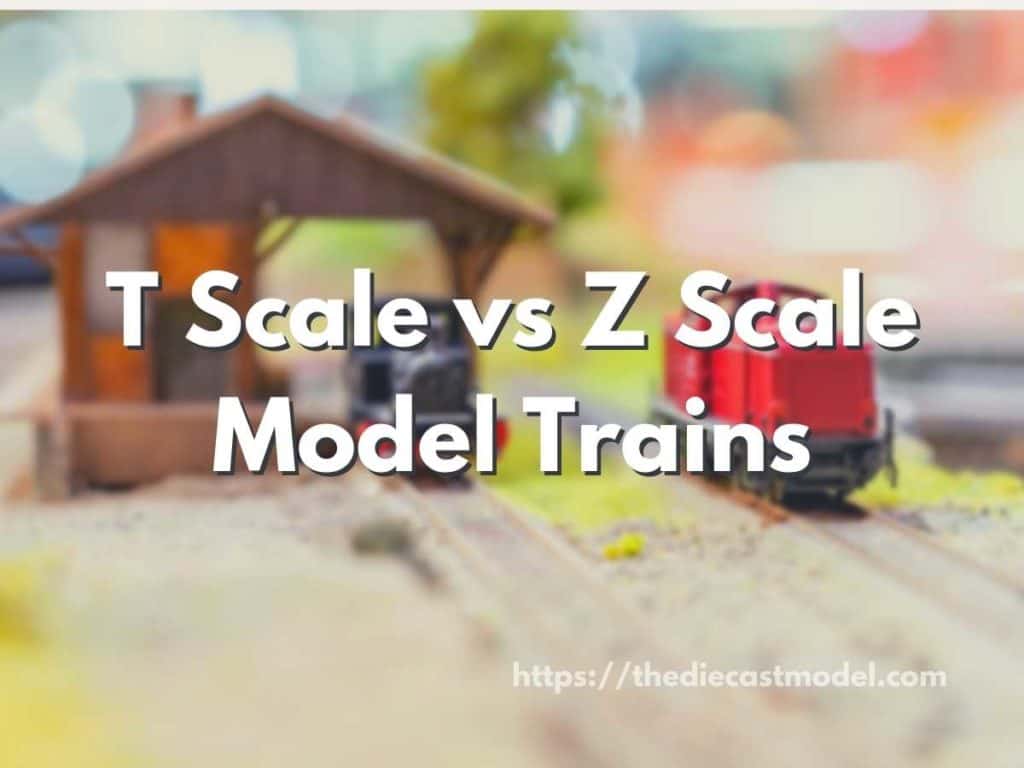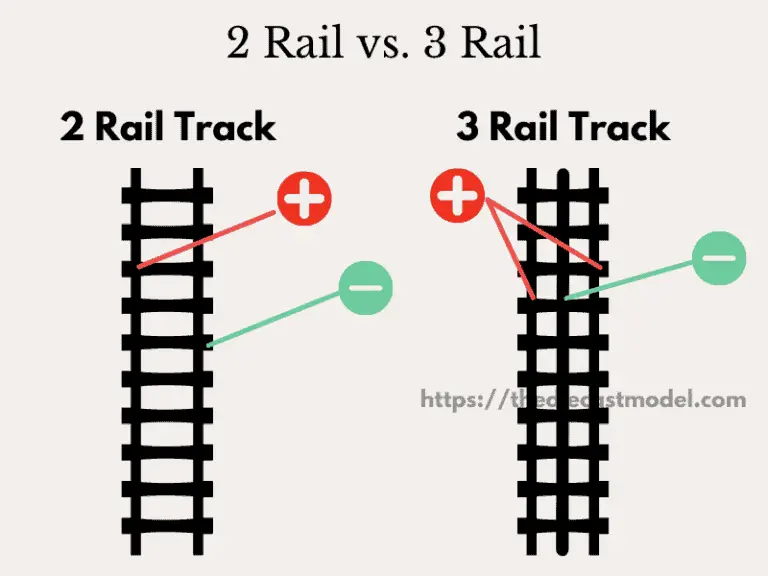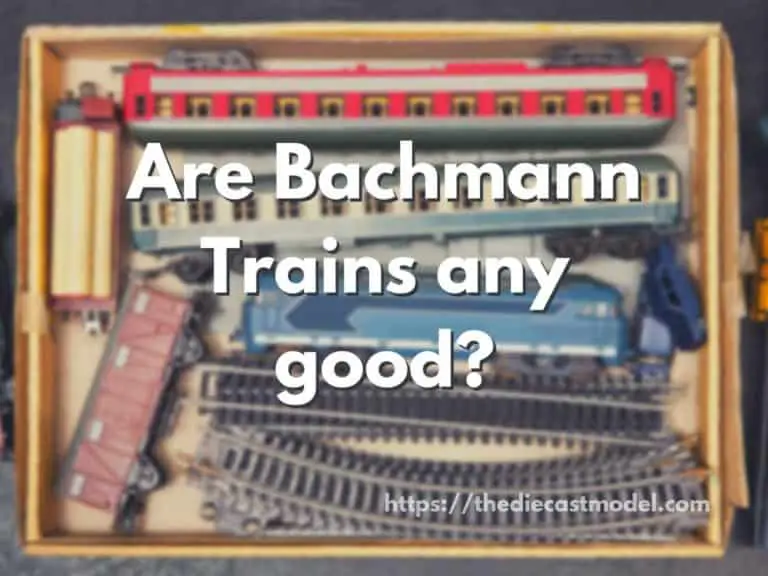T Scale vs. Z Scale Model Trains: Which is the Smallest Model Train Scale?
There is an ongoing trend of people preferring small over large model trains, which is apparent with the T and Z scale models. These scales are considered very small that you can fit an entire layout in a 12-inch space. Their train cars are so small that they can fit in our fingers. Most people think that the Z scale is the smallest, but there is a scale that was introduced in the late 2000s that is smaller than the Z scale.
The T scale is smaller than the Z scale because its models are produced in the 1:480 scale compared to the Z scale, which is produced at the 1:220 scale. In context, the T scale is half the size of the Z scale and a third the size of the N scale.
This post will discuss the going trend for smaller scales. What made people go with smaller scales, and what should people consider when going for these small scales. Furthermore, we will discuss the T and Z scales which are considered as the smallest scale. Finally, I will give my insight on what you should choose depending on your preference.

Is T scale smaller than Z scale?
| Z Scale | T Scale | |
| Scale Origin | Nuremberg Toy Fair | Tokyo Toy Show |
| Year of Introduction | 1972 | 2006 |
| Name Origin | Last Letter of the Alphabet for Smallest | Three Millimeter or Third of N Scale |
| Scale | 1:220 | 1:480 |
| Gauge | 6.5 mm / 0.256 in | 3 mm / 0.12 in |
| Scale to Feet | 1.385 mm to 1 ft | 0.635 mm to 1 ft |
| Popularity | More Popular | Less Popular |
There is an ongoing trend towards smaller-scale models. This is apparent with the N scale models, which now account for 20% of the train models sold worldwide.
Before, the most popular scale models were the large O scale and the HO scale. Then, however, the rising trend shifted with the HO scale being the most popular and the N scale is the second most popular.
There are many reasons why people started switching to smaller scales, such as the N scale. But the most common cause is space.
With many people living in smaller apartments instead of large homes, people started to think of ways in getting into model railroading while using less space. That’s where small scales like the N scale became popular.
However, the N scale is not the smallest model scale since the N scale is only on the 1:160 scale.
To briefly introduce scales, the scale is the relative size of the replica compared to the actual model. So, for example, if we say that the model is an N scale, a 1:160 scale model, it means that the actual model is 160 times larger than the replica.
That is why a larger scale means the model is smaller. If the N scale is 1:160, other models go smaller than this scale.
These are the T and the Z scale. Both of them are smaller than the N scale by a considerable margin.
To give more context, the N scale layout usually requires at least 2 feet of space to form an oval layout which includes the tracks and the train.
However, if you go with the T or Z scale, you would only need a foot of space to form an entire layout.
That is substantial space-saving considering the rising cost of living spaces in cities worldwide.
However, while smaller scales have the advantage of saving space, there is a reason why it is still not as popular as the large HO scale.
This is because smaller scales aren’t recommended for older modelers because of aging. With aging comes weaker eyesight, making it harder to operate a small model train layout.
That’s why many old train modelers stay with the HO scale or even the O scale despite the large space requirements.
Thus, I do not recommend going for smaller scales, especially if the modeler is above age 40.
Now that I provided some insights on when to consider and when not to consider small scale models let’s talk about the two smallest model train scales.
The smallest commercially available scale train is the Z scale introduced in Märklin in 1972 at the Nuremberg Toy Fair.
This scale was named the Z scale because Z is the last letter of the alphabet, and they think that means it will be the smallest train scale ever made.
At that time, they were right, and the Z scale became the smallest train model scale for more than three decades.
The Z scale is still considered the smallest commercially available train up to this date.
The Z scale is 1:220 in scale. The size of its replicas is 1.385 mm to 1 ft of the actual model. This means for every foot of the real train; the model will have a 1.385mm size. This scale model is so small that its rails are only 6.5mm or 0.256 inches wide.
This means it can fit an entire layout, including the tracks, design, and train in 1 square foot.
The Z scale is the smallest commercially available train scale since it can be bought in train stores around the world. However, there is an exclusive train scale sold in Hong Kong that is smaller than the Z scale.
That is the T scale.
The T scale is the smallest train scale worldwide. It was introduced in 2006 in a Tokyo Toy Show and became commercially available in 2007.
In 2009, it became an exclusive scale sold by Railway Shop in Hong Kong.
The T scale is on the 1:480 scale. This means the actual train will be 480 times larger than the replica.
To give more context, its rails are only 3 mm wide. The three-millimeter-wide rails are the reason why it is called the T scale.
Another reason for its name is that it is a third the size of the N scale.
If the Z scale is 1.385 mm to 1 ft, the T scale is 0.635mm to 1 ft. This is a massive reduction of size, and an entire T scale locomotive can fit into a person’s finger.
Now that I’ve introduced the T and Z scale let’s compare their sizes in the next section. Furthermore, we will discuss what I recommend and when to use both scales.
T scale is 1:480 (3 mm gauge or a third of N scale) 0.635mm to 1 foot. It was introduced in 2006 in a Tokyo Toy Show.
What is the smallest scale model?
The smallest scale model is the T scale which is 1:480 the size of the actual model. This means the actual model is 480 times larger than the replica. Its relative size is 0.635mm to 1 ft. This means a 2 ft actual model will only be about 1 millimeter in length if converted to the T scale.
I talked earlier about the T scale, which is the smallest scale. However, I also said that the Z scale is the smallest commercially available model train.
The T scale is an exclusive scale sold by Railway Shop in Hong Kong. This means any T scale locomotives, rails, and layout designs can only be bought in that shop.
This is also why T scale models are costly. Its exclusivity means its stock is greatly controlled.
On the other hand, Z scale models are available in numerous train stores worldwide. That is why more people have Z scale trains than the T scale.
However, the T scale is so tiny that you can make an entire layout with only half a square foot of space. The T scale is popular in Hong Kong because it is one of the most expensive living spaces in the world.
The Z scale dominates other parts of the globe since it is more commercially available.
If the Z scale is more popular, when will you use the T scale? Are there advantages of using the T over Z scale? We will talk about that in the last section.
Should you get the T or Z Scale?
Generally speaking, you should get Z scale because it is more common than T scale. Plus, Z scale models are usually cheaper than T scale models. The only reasons to use T scale over Z scale models are if you only have less than a square foot for model railroading or include plane models in the layout.
While having the smallest train layout might seem cool, the T scale layout isn’t recommended except if you live in congested areas like Hong Kong.
Since Railway Shop is in Hong Kong, you can easily access T scale models, including locomotives, designs, and tracks. Furthermore, the land cost in Hong Kong makes up for the premium price of T scale models.
However, getting your hands on T scale models will be extremely hard due to their exclusivity if you live outside Hong Kong.
Thus, people outside Hong Kong should stick with Z scale models.
You will have more choices on the trains, tacks, and layout with Z scale models since they are available worldwide compared to the exclusivity of the T scale.
In fact, the only reason to use the T scale over the Z scale if you’re outside Hong Kong is if you are going to include plane models in your layout.
There are plane models in the 1:400 or 1:500 scale, which is compatible with the T scale. If you plan to make your layout this extensive, having a T scale layout will be worth it.
Other than that, staying with Z scale models is the way to go since they are generally cheaper because it’s not as exclusive as the T scale.
In the future, when T scale models become more common, this might change.
But for now, that’s my recommendation.
What’s next? Do you know the popular brands for model railroading? I made a post talking about each popular model train brand and their strengths to help you choose which one to get depending on your need. You can find it here: What are the best model train brands?







